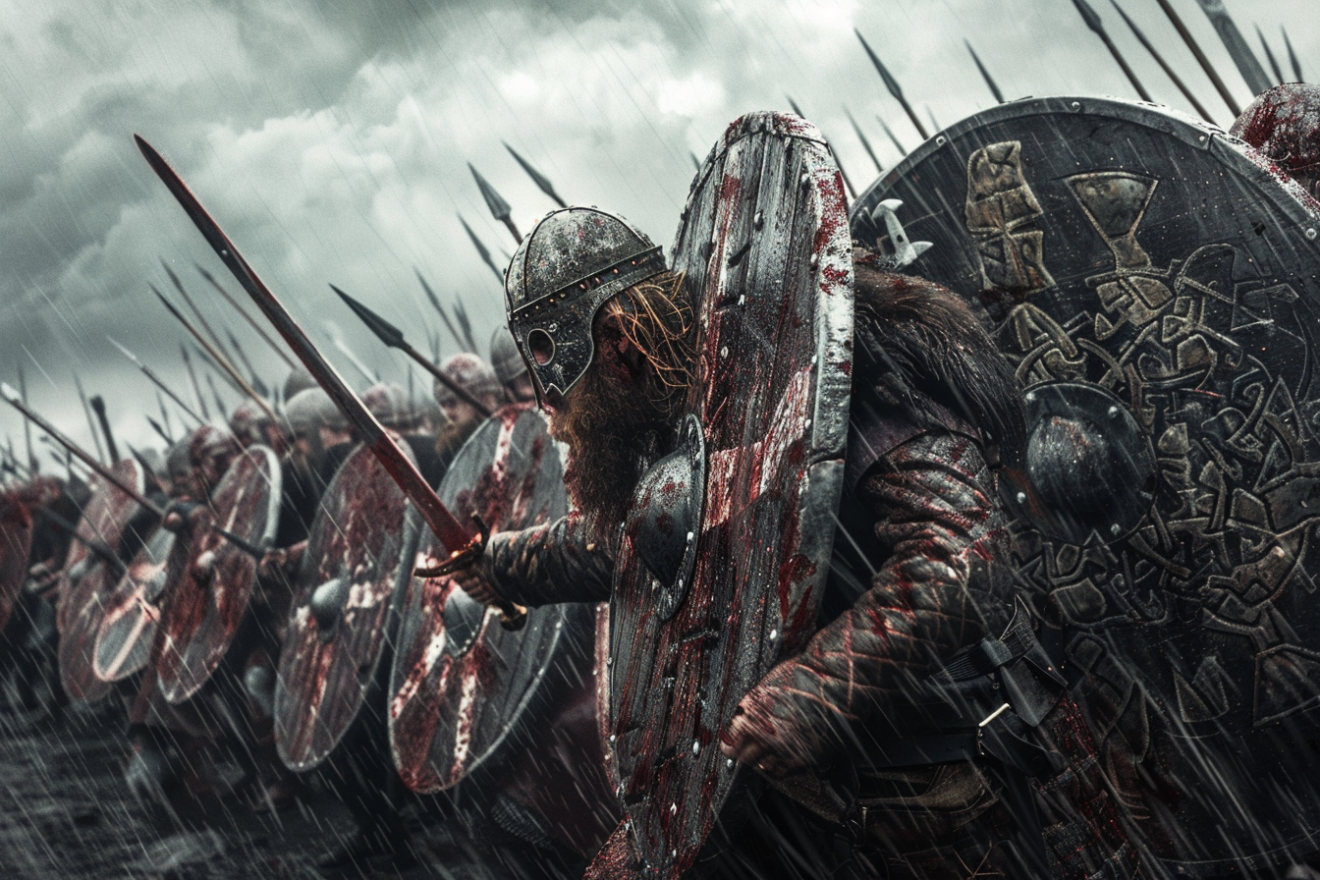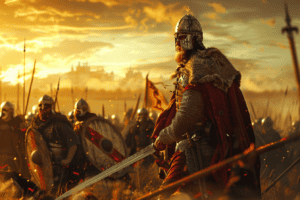Shield-wall assaults were a common tactic used by Vikings in ancient battles.
The shield-wall formation was a tight formation of warriors standing shoulder to shoulder, holding their shields in front of them, and presenting a formidable barrier to their enemies. This tactic was highly effective and played a significant role in Viking warfare.

The shield-wall formation was not just a defensive tactic but also allowed the Vikings to launch coordinated attacks against their enemies.
The warriors would advance towards their enemies in a tight formation, using their shields to protect themselves from enemy attacks. Once they reached their enemies, they would use their swords and axes to strike down their opponents. The shield-wall allowed the Vikings to fight as a unit, relying on each other for protection and support.
The shield-wall formation was a strategic formation that allowed the Vikings to dominate ancient battlefields.
This formation was not only highly effective but also allowed the Vikings to fight as a cohesive unit, relying on each other for protection and support. The shield-wall was a testament to the Vikings’ tactical prowess and played a significant role in their success on the battlefield.
The Basics of Viking Shield-Wall Tactics

Understanding the Shield Wall Formation
The Viking shield wall was a defensive formation used in battle to protect warriors from enemy attacks.
The shield wall was a tightly packed formation in which warriors stood side by side with their shields overlapping, creating a barrier that was difficult for enemies to penetrate. The formation was effective at protecting warriors from arrows, spears, and other projectiles, and it allowed them to advance on enemy positions while minimizing casualties.
The shield wall was typically formed in a straight line, with the strongest warriors positioned in the front and center. The warriors in the back ranks would use their shields to protect themselves and their comrades from attacks from above. The shield wall was also used to channel enemy forces into a narrow front, making it easier for the Vikings to counterattack.
Roles and Equipment of Viking Warriors
In the shield wall formation, each warrior had a specific role to play.
The front-line warriors, known as the “shield-bearers,” were the strongest and most experienced fighters. They were responsible for holding the line and repelling enemy attacks. The warriors behind them, known as the “sword-bearers,” were armed with swords and were ready to step forward and attack when the opportunity arose.
Viking warriors were equipped with a variety of weapons, including swords, spears, axes, and bows. However, the most important piece of equipment for a Viking warrior was their shield.
Viking shields were typically made of wood, with a metal boss in the center to protect the warrior’s hand. The shields were often decorated with intricate designs and symbols.
Strategic Advantages in Combat

The Viking shield-wall was a strategic formation that played a significant role in their success on the battlefield. It was a formation that required soldiers to stand shoulder-to-shoulder, holding their shields in front of them, and overlapping them with the shields of the soldiers next to them. This formation provided the Vikings with several strategic advantages in combat.
Psychological Impact on the Enemy
The sight of the Viking shield-wall was often enough to strike fear into the hearts of their enemies. The formation was an intimidating sight, and the sound of the shields clashing together as the Vikings marched forward was a terrifying sound.
This psychological impact on the enemy often caused them to panic and break formation, which made it easier for the Vikings to gain the upper hand in battle.
Defensive Strength and Offensive Capabilities
The Viking shield-wall was not just a defensive formation. It was also an offensive formation that allowed the Vikings to push forward and attack their enemies.
The overlapping shields provided excellent protection against enemy attacks, and the soldiers could use their shields as weapons to push back against the enemy.
The Viking shield-wall was also an effective way for the Vikings to control the battlefield.
By standing shoulder-to-shoulder, the Vikings could create a barrier that was difficult for the enemy to penetrate. This allowed the Vikings to dictate the pace of the battle and choose when and where to attack.
Cultural and Historical Significance

Viking Social Structure and Military Tactics
The Viking Age was a time of great cultural and historical significance. During this period, the Vikings developed a unique social structure and military tactics that helped them to dominate the battlefields of ancient Scandinavia.
At the heart of the Viking social structure was a system of clans and tribes that were bound together by a shared sense of identity and loyalty. Within these clans and tribes, warriors played a central role in maintaining order and defending their communities from external threats.
To achieve success on the battlefield, the Vikings developed a range of innovative military tactics that were designed to take advantage of their strengths and exploit the weaknesses of their opponents. One of the most effective of these tactics was the shield-wall assault, which involved forming a tightly packed formation of warriors armed with shields and spears.
This formation was incredibly effective at repelling enemy attacks and allowed the Vikings to maintain a strong defensive posture while also launching devastating counterattacks.
Legendary Sagas and the Legacy of Viking Battles
The Viking Age is also known for its legendary sagas and the legacy of Viking battles. These sagas were stories of heroes and epic battles that were passed down from generation to generation and helped to shape the cultural identity of the Viking people.
They were often embellished with supernatural elements and served as a way of reinforcing the values and beliefs of Viking society.
The legacy of Viking battles can still be seen today in the many artifacts and ruins that have been uncovered by archaeologists. These artifacts provide us with a glimpse into the lives of the Viking warriors and the tactics that they used to achieve victory on the battlefield.
They also serve as a reminder of the incredible cultural and historical significance of the Viking Age and the enduring legacy that it has left behind.
Evolution and Decline of Shield-Wall Assaults

Shield-wall assaults were a defining feature of Viking warfare, and their effectiveness on the battlefield cannot be overstated. However, as with any military tactic, the shield wall had its strengths and weaknesses, and over time, adaptations and counter-tactics emerged.
Adaptations and Counter-Tactics Over Time
As the Middle Ages progressed, the shield wall began to face new challenges.
One of the most significant was the rise of the crossbow, which could penetrate the shields of even the most well-trained warriors. In response, Vikings began to develop new tactics, such as the use of archers to suppress enemy fire.
Another adaptation was the use of cavalry charges to break up enemy formations. This was particularly effective against shield walls, as the horses could trample the defenders and create gaps in their lines.
The Vikings also began to incorporate more mobile infantry units, such as light skirmishers armed with javelins, to harass enemy formations and disrupt their cohesion.
The Last Stand: Battle of Stamford Bridge
Despite these adaptations, the shield wall remained a potent force on the battlefield well into the 11th century. However, its decline was hastened by a series of defeats, culminating in the Battle of Stamford Bridge in 1066.
In this battle, a Viking army under the command of Harald Hardrada was defeated by a combined force of English soldiers under King Harold Godwinson.
The battle was notable for its ferocity and the use of shield walls on both sides. However, the Vikings were ultimately defeated due to their inability to adapt to changing battlefield conditions.
They were caught off guard by the speed and mobility of the English army, which was able to outflank and surround them.
The shield wall was a dominant military tactic during the Viking Age, but it was not invincible. Over time, adaptations and counter-tactics emerged, and the shield wall was eventually superseded by more flexible and mobile formations.
The Battle of Stamford Bridge marked the end of an era, and the beginning of a new age of conquest and defeat.










Add Comment